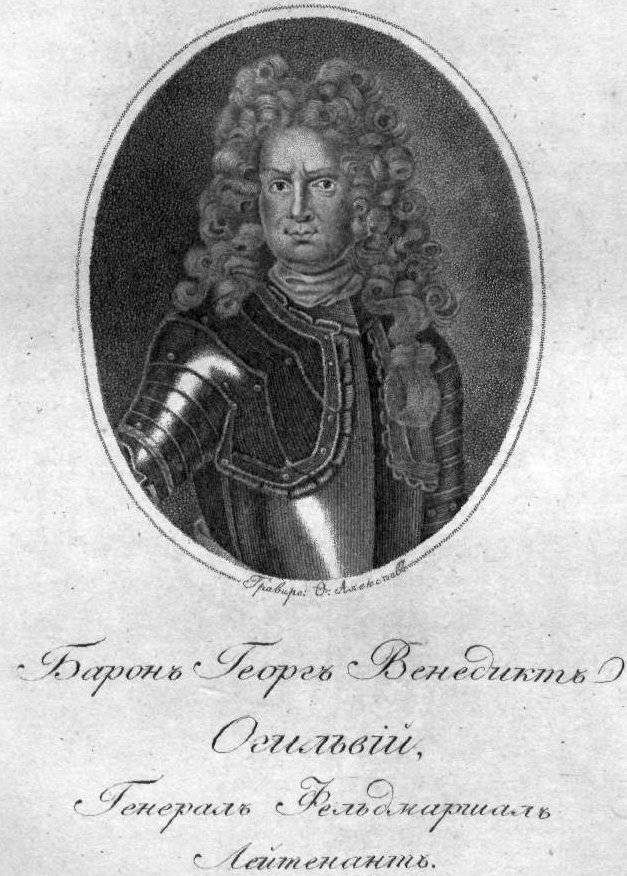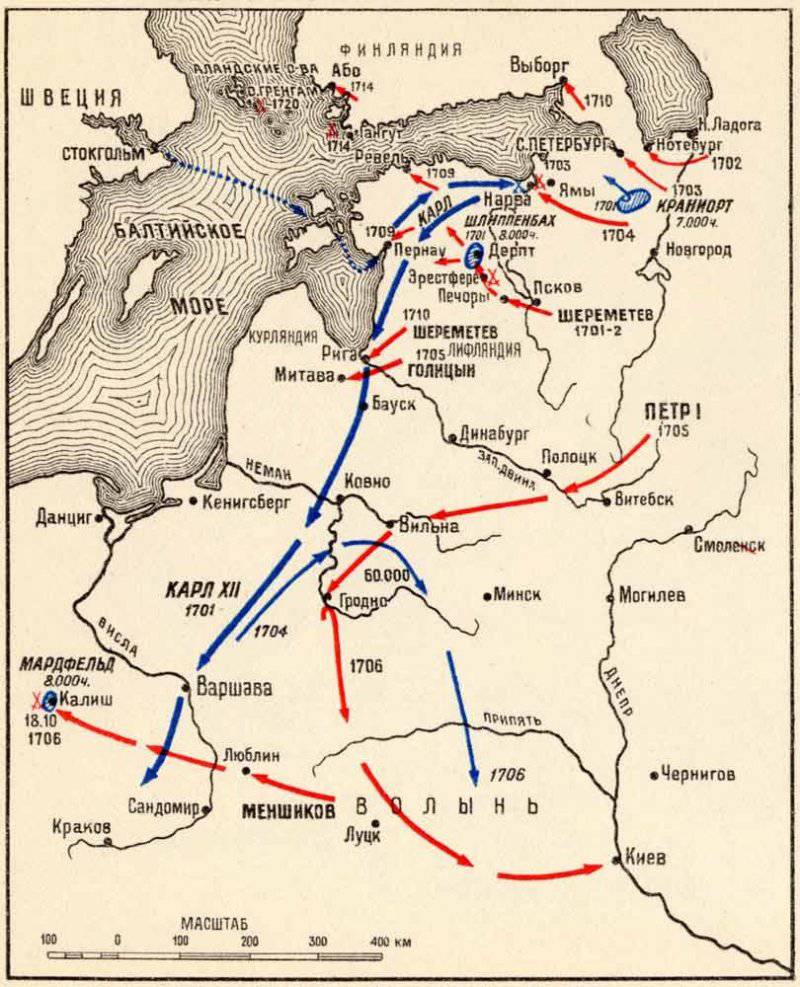Grodno maneuver of the Russian army
In 1705, Peter I planned to take Vyborg and Kexholm to create a solid defensive line north of the Neva. But, "man assumes, and God disposes," the course of the war within the Commonwealth - with Russia's ally Augustus II, forced Peter to shift his attention to another theater of war.
While the Russian army was winning one after the other victories in the Baltic States, the Swedish army occupied the main vital centers of Poland. Carl didn’t care much about the success of the “Russian men”, he planned to crush Russia with one blow after the defeat of Augustus. In fact, Karl, although not encountering any particular resistance, was “stuck” in Poland, several times proceeded far and wide, scored a number of victories over Augustus’s troops: Warsaw was taken in 1701, and Torun and Krakow won in 1702. 1703 year - at Danzig and in Poznan. In 1704, Karl gathered the Warsaw Sejm (estate-representative body in Rzecz Pospolita, he had legislative and partly judicial power, had the right to elect a monarch), who declared Augustus deposed. A Swedish henchman, the Poznan voivode Stanislav Leschinsky (ruled before 1711 of the year), was elevated to the throne. A significant part of the nobility did not recognize him king, and supporters of Augustus created Sandomierz Confederation. She recognized the decision of the Warsaw Diet invalid and declared war on Sweden. Poland was split into two camps. 19 (30) August 1704 of the year near Narva Russian Ambassador Fedor Golovin and Polish Ambassador Tomasz Dzialinski signed an agreement (Treaty of Narva) on the continuation of a joint war against the Swedish Empire. The agreement officially announced the entry of Poland into the war. The parties pledged to coordinate military action against the Swedish army and not to conclude a separate peace. The Poles promised to put 48 thousand army, Russia had to pay Poles for 200 thousand rubles annually, up to the expulsion of the Swedish forces from the Polish land. In addition, Russia was supposed to put 12 thousand auxiliary building to help the Poles and return all Polish cities, recaptured from the Swedes.
Moscow sent to help Augustus 17 thousand auxiliary corps under the command of Golitsyn. In August 1704, the combined Polish-Saxon and Russian forces occupied Warsaw. At this time, Karl was in Galicia. In early September, he approached Lviv, the city was well fortified, had a garrison and proper reserves, but could not resist for a long time - on the night from 5 (16) to 6 (17) September, Karl's army captured him. Lviv was ravaged, then the Swedish army went to Zamoостьюć and the bank of the Vistula, reached Warsaw. Augustus did not dare to take the fight, his army retreated to Krakow, and then to Dresden. Karl decided to cut off Poland from Saxony - by the winter of 1704-1705, the Swedish army had embarked on winter apartments in Silesia. The army of Augustus was divided — the Polish and Saxon cavalry remained with Krakow, and the Saxon infantry and the Russian corps were driven back over the Oder.
With the start of the 1705 campaign of the year, Augustus retreats to Lublin, and then to Brest-Litovsk, this made it possible to establish contact with the Russian troops. Back in January 1705, the Sheremetev detachment was sent to the Lithuanian border in 5. By the spring of 1705, on the orders of Peter, the main forces of the Russian army were concentrated in the Polotsk area. From Polotsk, the Russian army could strike at Riga or move to Poland. Karl, responding to the threat - Riga was the main intermediate base between Sweden and the Swedish army in Poland, ordered Levengaupt to concentrate all Swedish forces scattered around Kurland and Livonia in the Riga region.
The right flank was secured when a detachment of Levengaupt appeared at Mitavy. July 15 in a battle at Gemauertgof Sheremetev could not beat the Swedes and was rejected. But Peter, with the Preobrazhensky regiment and Repnin's division, came to the rescue, Levengaupt, having learned about it, retreated, leaving small garrisons in Mitau and Bauska. Peter took them at the beginning of September, this provided the Polotsk-Grodno operating line.
Then Peter moved the army to Grodno. This decision was made for several reasons. First, Grodno, stood on the direct route to Warsaw, and from there it was possible to threaten the communications of the Swedish army in the event of their movement to Saxony. Secondly, the Russian troops could threaten the reports of Charles with the Swedish forces in Estland and Livonia: the best roads from Warsaw to Riga passed through Grodno. Polish, Lithuanian, and Saxon formations were also attached here. At the direction of the Russian tsar, a fortified camp was set up — a shaft reinforced with artillery was poured behind the moat. A bridgehead was erected near the northwestern part of the city.
The allied army was located in the winter quarters - Peter and August did not expect to fight in the winter of 1705-1706, believing that Karl would refrain from major operations. The Russian tsar left for Moscow, Augustus also left Grodno and moved to Saxony, transferring the command to Field Marshal Georg Ogilvi (he had been in the Russian service since the second siege of Narva). Augustus took with him the 4 Dragoon Regiment of 6, who were in the camp. This had a negative effect on the garrison of the camp - there was not enough cavalry to get food and forage in the surrounding areas.

Karl violated the customs of the war then accepted, and at the end of December his 20 thousand army moved to Grodno. 13 January 1706, he crossed the Neman in 3 km above Grodno. By this time, the entire Russian infantry and part of the cavalry were concentrated in the Grodno area (the 45 infantry battalions and the 2 dragoon regiments - only about 30 thousand bayonets and sabers). A part of the army - the cavalry avant-garde under the command of Menshikov was cut off from the main army and located at Minsk (up to 10 thousand people). Another part of the army took with him Augustus.
The Swedish king deployed his army 10 kilometers from Grodno and decided to block the camp of the Russian army in order to force it to capitulate. Russian troops were cut off from all communications, the army was threatened with hunger. The decisive actions of Charles put the best parts of the Russian army in a very difficult position. The army could not accept the fight, it had practically no cavalry, the situation was getting worse every day.
Peter at the news of an unexpected maneuver of the Swedish army tried to return to the army, but could not. Communications have been cut. He set up his headquarters in Orsha, then in Minsk, and was forced to tackle several difficult tasks at once: to prevent the connection of Karl’s army with the Levengaupt corps; facilitate the position of a blocked army; disturb the Swedish army from the rear and prepare the frontiers of Russia for a possible invasion.
Peter held a series of events. He ordered to organize food bases in Slutsk and Minsk in case of a withdrawal of the Russian army there and to prepare them for defense. Herman Mazepa with the 15 ths. Cossack detachment was instructed to stand at Slutsk and disturb Swedish communications on the way to Warsaw. In addition, the Cossacks were supposed to establish contact with Grodno. The cavalry detachment of Bour received an order to control the road Vilna - Polotsk, to disturb the Swedish army, not to allow Karl and Riga to communicate, the cavalrymen of the detachment Rosen from Mitau to look after the actions of Lewenhaupt in the Riga region. The Russian garrisons in Mitau and Bauska were supposed to blow up the fortifications at the extreme position and retreat to Polotsk. At the same time, work was underway to strengthen the fortresses on the western border. Military construction work was carried out in Pskov, Smolensk, Velikiy Luki, Moscow. Along the border line along the Pskov - Bryansk line and further south began to build abutments, fortifications, closing the most dangerous directions. The local population was mobilized for the construction of notches and fortifications.
The Swedes were not able to organize a tight blockade, because of the lack of food they had to move 7 in February 1706, to Zheludek. The Russian army had the opportunity to retreat. February 27 Peter ordered Ogilvy to withdraw the army in the direction of Brest - Kiev. The king ordered to use the spring ice drift, flood, to cross over to the left bank of the Neman and depart, covering the Polesie marshland with Kiev (or Chernigov). "Hired field marshal" G. Ogilvy long hesitated with the implementation of the orders of the king about the withdrawal of the Russian army, referring to the need to wait for the arrival of Saxon troops and the continuation of joint actions. Peter told him there was no hope for the Saxons, and March 12 sent a decisive directive demanding to leave immediately.
The maneuver was well calculated: the Russian army had a permanent bridge across the Neman River, and the Swedes had only a temporary bridge at the town of Orel. March 24 ice drift destroyed the Swedish bridge, and Russian troops safely crossed to the other side and, having received a time advantage, began to leave. The March 27 army was in Tykocin, where it joined the Menshikov detachment, and on May 8, the army reached Kiev almost without loss. Troops were saved.
Karl did not expect such a maneuver, he had to assemble parts of his army. His army was able to cross the other side only on April 3 (14) and moved to Pinsk. The flood, the marshland, the distracting actions of the Cossacks - all this impeded the movement of the Swedish army. As a result, Karl was stuck in the Pinsk swamps, and the Swedish command refused to pursue the Russian army. Instead, Karl threw his troops to the destruction of cities and fortresses, where the Polish and Cossack garrisons were located, Polesia was devastated. In Lyakhovichi, a detachment of Pereyaslavsky colonel Ivan Mirovich was blocked. He was sent to the aid of a regiment of Seeds Neplyuev, which was supposed to be connected with the Mirgorod regiment of the Zaporozhian Colonel Daniil Apostol. As a result of the battle at Kletsk - 19 (30) on April 1706, the Cossack cavalry panicked and trampled on Neplyuev infantry. The Swedish 1,5 thousand squad was able to defeat the 5 thousand Russian squad. 1 May Lyakhovichi capitulated. These failures did not have much impact on the war.
May 22 Karl led the army to Volyn, stood there for about 2 months, then again moved the troops against Augustus to complete his rout. By early September 1706, the Swedish army was stationed in the vicinity of Leipzig.
Results of operations 1705-1706.
- The Russian command correctly estimated the situation, postponing the operation in Finland. Russia did not allow the enemy to destroy his only ally.
- The command has chosen the right place for the location of the army - between the main forces of the Swedish army and the Swedish Baltic states. The right flank of the army was secured - they took Mitawa and Bauska, the actions of Levengaupt were under control.
- Karl with unexpected and active actions disrupted the plans of the leadership of Saxony and Russia, but could not crush the Russian army. After that, he again took up Augustus.
- The Russian army conducted a skillfully organized retreat. Russia won another year to strengthen and improve the army and fleet.

Information